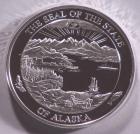1992 Alaska Medallion - The Eagle


Current List Price $475.00
Like some of the other back issue Alaska medallions, the 1992 Eagle has become difficult to find.
Please CONTACT US for availability information.
The eagle is a stunning design and the most rare of all our medallions. The 1992 Eagle was the first Official State Medallion put out by the Alaska Mint (at that time called the "Anchorage Mint"). Most of the 3,457 Proof medallions sold that year were purchased by visitors to the State who had no idea these medallions would become so rare and sought after. As the medallions scattered to the four corners of the planet most were simply tossed in drawers and forgotten. Today a good place to find a proof (smooth edge with a serial number) Eagle is in a flea market, a garage sale, or in the bottom of a display case at an unsuspecting coin dealer. Click the above image to see the wonderful detail of this first medallion in the series by the Alaska Mint.
The Bald Eagle is so named for its conspicuous white head and tail. The distinctive white adult plumage is not attained until 5 or more years of age. Immature birds lack this easily identifiable characteristic and can be confused with the Golden Eagle. The immature Bald Eagle’s featherless tarsi (lower legs) and whitish wing linings on the forward part of the wings can be helpful distinctions where the two species coexist. The Bald Eagle is Alaska’s largest resident bird of prey (the Steller’s Sea Eagle is larger) with a wing span up to 7 1/2 feet (2.3 m) long and weights of 8 to 14 pounds (3.6-6.4 kg). Like many raptors, females are larger than males. Bald Eagles often use and rebuild the same nest each year. Nest trees are usually close to water, afford a clear view of the surrounding area, and often provide sparse cover above the nest. In Southeast Alaska, Bald Eagles usually nest in old-growth timber along saltwater shorelines and Mainland Rivers. Eagles in South-central Alaska nest in old cottonwood trees near water. Nest building begins in April, and both the male and female gather nest material. In late April, two (sometimes three) dull white or creamy yellow eggs are laid several days apart. Incubation lasts about 35 days. When the young hatch, sibling rivalry is common and the weaker, usually the younger, chick is killed or starved. The surviving young leave the nest after approximately 75 days. They do not attain adult plumage and breed until 4 or 5 years of age. After the breeding season, Bald Eagles congregate where food is plentiful, and they may continue to roost near the nest tree.
Silver Trivia:
Throughout history, wearing silver jewelry was often a social privilege - not a right - reserved for upper classes.
Silver jewelry was a significant indicator of status until the very end of the 18th century, because it was limited to a privileged few. It was the Industrial Revolution, through mass manufacturing, which finally made jewelry available to the general population.
Silver is used by the cinema industry to form its 'images of the silver screen'. Silver has always been the staple metal used for making films, in colors as well as in black and white, and the film industry is a major drain on the world's silver reserves.
